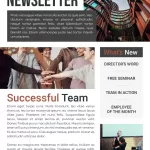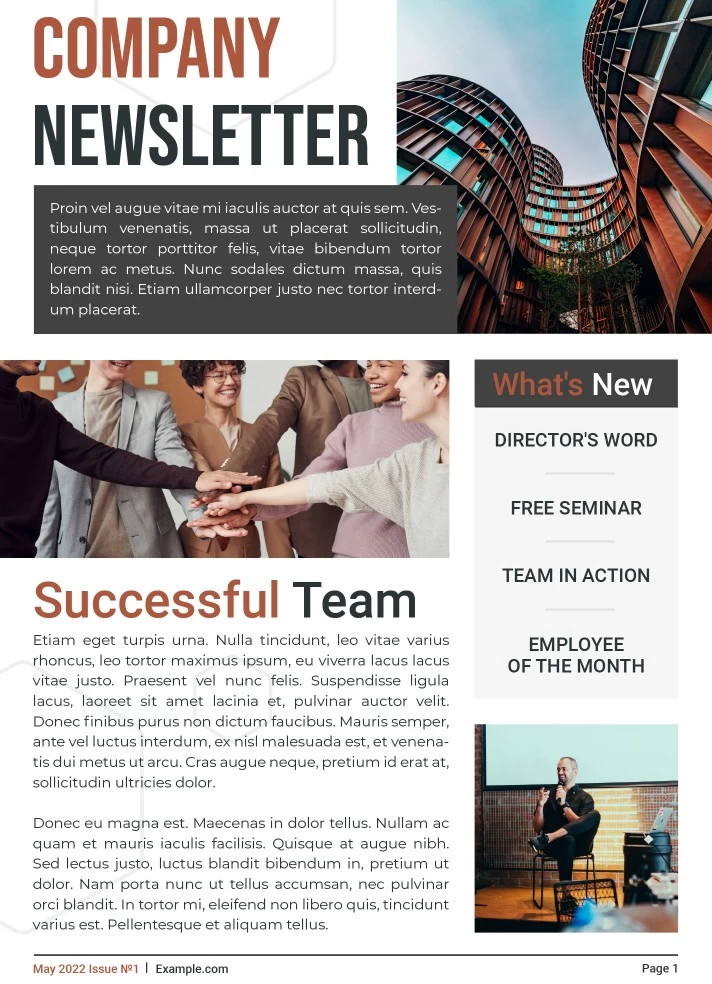Identifying the audience for a community services newsletter is crucial for ensuring the content is relevant and engaging. Here are five examples of audience identification for newsletters in different sectors:
- Child and Family Services Newsletter Audience:
- Social workers and child welfare professionals
- Family support organizations and counselors
- Local government agencies involved in child and family welfare
- Non-profit organizations focused on child development and family support
- Community volunteers and advocates for children’s rights
- Parents and families seeking resources and support
- Education Society Newsletter Audience:
- School administrators and teachers from local schools
- Educational researchers and policy makers
- Representatives from educational non-profits and NGOs
- Local community education centers and adult education providers
- Students and parents interested in educational developments
- Local businesses and organizations involved in educational sponsorships or partnerships
- Health Services Newsletter Audience:
- Healthcare providers, including doctors, nurses, and therapists
- Hospital and clinic administrators
- Public health officials and policy makers
- Health advocacy groups and non-profit organizations
- Medical researchers and academia
- Community members interested in health and wellness topics
- Fisheries Newsletter Audience:
- Local fishermen and fishing companies
- Environmental groups focused on marine and aquatic ecosystems
- Government agencies regulating fisheries and marine resources
- Marine biologists and environmental researchers
- Local businesses dependent on the fishing industry
- Community members interested in sustainable fishing and marine conservation
- First Nations Band Offices Newsletter Audience:
- Leaders and members of First Nations communities
- Government agencies involved in Indigenous affairs
- Cultural preservation groups and Indigenous rights advocates
- Researchers and academics specializing in First Nations studies
- Non-profit organizations working with First Nations communities
- Individuals and groups interested in learning about and supporting First Nations initiatives and culture
Setting clear goals and objectives is essential for the success and relevance of a community services newsletter. Here are examples for newsletters in various sectors:
- Child and Family Services Newsletter Goals and Objectives:
- Goal: Strengthen community support systems for children and families.
- Objectives:
- Provide monthly updates on new child welfare policies and legislation.
- Feature success stories and case studies from local child and family service organizations.
- Offer resources and training opportunities for professionals in child and family services.
- Create a platform for discussing challenges and sharing best practices in child and family welfare.
- Education Society Newsletter Goals and Objectives:
- Goal: Enhance collaboration and innovation in the education sector.
- Objectives:
- Share the latest educational research findings and teaching methodologies.
- Highlight innovative educational programs and initiatives within the community.
- Promote professional development opportunities for educators.
- Foster partnerships between schools, local businesses, and community organizations.
- Health Services Newsletter Goals and Objectives:
- Goal: Improve public health awareness and healthcare service delivery.
- Objectives:
- Update the community on health trends, new treatments, and public health issues.
- Showcase advancements and achievements in local health services.
- Provide a forum for healthcare professionals to exchange ideas and solutions.
- Offer health education resources and wellness tips to the general public.
- Fisheries Newsletter Goals and Objectives:
- Goal: Promote sustainable fishing practices and marine conservation.
- Objectives:
- Report on changes in fisheries regulation and marine environmental policies.
- Feature articles on sustainable fishing techniques and success stories.
- Facilitate collaboration between fishermen, environmental groups, and regulatory bodies.
- Educate the community on the importance of marine ecosystems and conservation efforts.
- First Nations Band Offices Newsletter Goals and Objectives:
- Goal: Support and empower First Nations communities.
- Objectives:
- Provide updates on policies and initiatives relevant to First Nations.
- Celebrate cultural heritage and share news on cultural events and activities.
- Offer a platform for First Nations leaders to voice community concerns and aspirations.
- Facilitate knowledge sharing and collaboration between different First Nations communities and external stakeholders.
Deciding on the frequency and format of a community services newsletter is crucial for its effectiveness and accessibility. Here are examples for different sectors:
- Child and Family Services Newsletter:
- Frequency: Bi-monthly
- Format: Digital format with interactive elements like video interviews and clickable resources. A section for urgent updates or bulletins which can be dispatched as needed. The newsletter should be easily accessible on mobile devices and visually engaging to facilitate quick reading.
- Education Society Newsletter:
- Frequency: Quarterly
- Format: A mix of digital and printed formats. The digital version could include multimedia elements like instructional videos or podcasts featuring interviews with educators. The printed version would be useful for sharing in schools and education centers that prefer physical copies.
- Health Services Newsletter:
- Frequency: Monthly
- Format: Primarily digital format focusing on high readability and accessibility, including text-to-speech features for those with visual impairments. A concise, well-structured layout with sections dedicated to different health topics, new research summaries, and community health events.
- Fisheries Newsletter:
- Frequency: Seasonal (4 times a year)
- Format: Digital format with emphasis on visual content such as infographics and maps showing fishing areas, trends, and conservation data. This would cater to the practical needs of the fisheries community, who often prefer quick, visual data they can use in their day-to-day operations.
- First Nations Band Offices Newsletter:
- Frequency: Bi-monthly
- Format: A combination of digital and print, respecting the diverse preferences within First Nations communities. The content should include both English and relevant Indigenous languages, featuring cultural stories, news, and important updates. The format should be respectful and reflective of the cultural values and aesthetics of the communities it serves.
Content planning is essential for creating a valuable and engaging community services newsletter. Here are examples for different sectors:
- Child and Family Services Newsletter Content Planning:
- Feature Article: An in-depth piece on new child protection laws and their impact.
- Interviews: Conversations with local child psychologists and social workers.
- Community Spotlight: Highlighting a family who benefited from local services.
- Resource Section: Up-to-date listings of workshops, training sessions, and support groups.
- Expert Column: Monthly advice from child development experts.
- News and Updates: Brief on recent changes in child welfare policies.
- Education Society Newsletter Content Planning:
- Feature Article: Analysis of emerging trends in educational technology.
- Teacher’s Corner: Sharing innovative classroom strategies and success stories.
- Policy Update: Overview of recent changes in education legislation.
- Event Calendar: Upcoming educational conferences, seminars, and workshops.
- Book Review: Highlighting a recent publication in the field of education.
- Student Showcase: Featuring exceptional projects or achievements by students.
- Health Services Newsletter Content Planning:
- Feature Article: Focus on new healthcare initiatives or breakthrough treatments.
- Interviews: Conversations with healthcare leaders or innovators.
- Wellness Tips: Regular section on health maintenance and disease prevention.
- Community Health Update: News about local health services and programs.
- Research Highlights: Summaries of recent health studies relevant to the community.
- Q&A Section: Health professionals answer common health questions from readers.
- Fisheries Newsletter Content Planning:
- Feature Article: Exploring sustainable fishing practices.
- Industry News: Updates on fisheries regulations and market trends.
- Environmental Focus: Articles on marine conservation and ecosystem health.
- Fisherman’s Tales: Personal stories and experiences from local fishermen.
- Tech Corner: Latest advancements in fishing technology and equipment.
- Event Calendar: Information on upcoming fisheries-related events and conferences.
- First Nations Band Offices Newsletter Content Planning:
- Feature Article: Coverage of significant developments in First Nations policies or initiatives.
- Cultural Spotlight: Stories or interviews that celebrate cultural heritage.
- Community Voices: Opinions and thoughts from community members on relevant issues.
- Event Calendar: Listing of upcoming cultural, educational, and social events.
- Youth Section: Content created by and for the younger members of the community.
- Health and Wellness: Information on health programs and services tailored for First Nations communities.
is essential for creating a valuable and engaging community services newsletter. Here are examples for different sectors:
- Child and Family Services Newsletter Content Planning:
- Feature Article: An in-depth piece on new child protection laws and their impact.
- Interviews: Conversations with local child psychologists and social workers.
- Community Spotlight: Highlighting a family who benefited from local services.
- Resource Section: Up-to-date listings of workshops, training sessions, and support groups.
- Expert Column: Monthly advice from child development experts.
- News and Updates: Brief on recent changes in child welfare policies.
- Education Society Newsletter Content Planning:
- Feature Article: Analysis of emerging trends in educational technology.
- Teacher’s Corner: Sharing innovative classroom strategies and success stories.
- Policy Update: Overview of recent changes in education legislation.
- Event Calendar: Upcoming educational conferences, seminars, and workshops.
- Book Review: Highlighting a recent publication in the field of education.
- Student Showcase: Featuring exceptional projects or achievements by students.
- Health Services Newsletter Content Planning:
- Feature Article: Focus on new healthcare initiatives or breakthrough treatments.
- Interviews: Conversations with healthcare leaders or innovators.
- Wellness Tips: Regular section on health maintenance and disease prevention.
- Community Health Update: News about local health services and programs.
- Research Highlights: Summaries of recent health studies relevant to the community.
- Q&A Section: Health professionals answer common health questions from readers.
- Fisheries Newsletter Content Planning:
- Feature Article: Exploring sustainable fishing practices.
- Industry News: Updates on fisheries regulations and market trends.
- Environmental Focus: Articles on marine conservation and ecosystem health.
- Fisherman’s Tales: Personal stories and experiences from local fishermen.
- Tech Corner: Latest advancements in fishing technology and equipment.
- Event Calendar: Information on upcoming fisheries-related events and conferences.
- First Nations Band Offices Newsletter Content Planning:
- Feature Article: Coverage of significant developments in First Nations policies or initiatives.
- Cultural Spotlight: Stories or interviews that celebrate cultural heritage.
- Community Voices: Opinions and thoughts from community members on relevant issues.
- Event Calendar: Listing of upcoming cultural, educational, and social events.
- Youth Section: Content created by and for the younger members of the community.
- Health and Wellness: Information on health programs and services tailored for First Nations communities.
Creating newsletter publications can be efficiently done using various software platforms, each with its unique benefits. Platforms like Microsoft Publisher, Canva, and Adobe InDesign are popular choices, offering different levels of customization, ease of use, and professional capabilities. Here’s how you can create newsletters with these platforms and the benefits of each:
- Microsoft Publisher:
- How to Create:
- Start by selecting a newsletter template or creating a design from scratch.
- Use the layout and design tools to add text boxes, images, and other elements.
- Customize your design with fonts, colors, and styles.
- Import any necessary content and images, then adjust their placement as needed.
- Preview and make final adjustments before saving or printing.
- Benefits:
- User-friendly for beginners.
- Integrates seamlessly with other Microsoft Office tools.
- Offers a variety of pre-designed templates.
- Good for basic to moderately complex designs.
- Canva:
- How to Create:
- Choose a newsletter template from Canva’s extensive library.
- Drag and drop design elements like text, photos, and icons.
- Utilize Canva’s photo library or upload your images.
- Customize the design with different fonts and color schemes.
- Download, share, or print directly from the platform.
- Benefits:
- Extremely user-friendly with a drag-and-drop interface.
- Access to a vast library of templates and design elements.
- Ideal for those with no professional design experience.
- Cloud-based, allowing for collaboration and accessibility from any device.
- Adobe InDesign:
- How to Create:
- Create a new document and set your desired page size and margins.
- Use master pages to create a consistent layout template.
- Add and format text and images using advanced layout tools.
- Leverage InDesign’s powerful typography and design features for customization.
- Export your newsletter as a PDF or print it directly.
- Benefits:
- Professional-level design software with advanced features.
- Excellent control over typography and layout.
- Ideal for creating complex and multi-page documents.
- Integrates well with other Adobe Creative Cloud applications.
Each platform caters to different skill levels and design needs. Microsoft Publisher is suitable for those already familiar with Microsoft Office and needing basic to moderate design capabilities. Canva is great for beginners and those requiring quick, attractive designs without needing extensive design skills. Adobe InDesign is best suited for professionals who need advanced design features and control over their layouts, making it ideal for complex and high-quality newsletter publications.
 Summary: This article will cover the initial stages of planning an in-house newsletter for organizations. It will focus on defining the purpose, identifying the target audience, and setting clear goals for the newsletter.
Summary: This article will cover the initial stages of planning an in-house newsletter for organizations. It will focus on defining the purpose, identifying the target audience, and setting clear goals for the newsletter.

